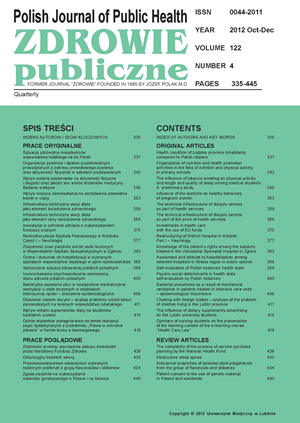Wpływ miejsca zamieszkania na zachowania zdrowotne kobiet w ciąży
DOI:
https://doi.org/10.12923/j.0044-2011/122-4/a.04Słowa kluczowe:
ciąża, zdrowie, aktywność fizyczna, samopoczucieAbstrakt
Wstęp. Aktywność ruchowa, nawyki żywieniowe, zachowania profilaktyczne, nastawienie psychiczne czy praktyki zdrowotne mogą mieć zasadniczy wpływ na przebieg ciąży i porodu.
Cel. Celem pracy było przedstawienie i porównanie postaw prozdrowotnych kobiet w ciąży, zamieszkałych na terenie dużego i małego miasta.
Materiał i metody. Grupę badaną stanowiło 171 kobiet w okresie połogu przebywających na oddziałach położniczych. Badanie zostało przeprowadzone w drugiej lub trzeciej dobie po porodzie, z wykorzystaniem autorskiej ankiety złożonej z 37 pytań.
Wyniki. Postawy ankietowanych kobiet ciężarnych były prozdrowotne. Ciąża skłaniała kobiety do podjęcia działań prozdrowotnych lub ich kontynuacji. Potwierdzono istotną zależność pomiędzy podejmowaną w ciąży aktywnością fizyczną a samopoczuciem i sprawnością fizyczną zarówno w trakcie jak i po ciąży.
Wnioski. Wobec uzyskanych wyników należy zwrócić szczególną uwagę na promocję zdrowego stylu życia kobiet w ciąży, w tym różnych form aktywności ruchowej oraz rozpowszechnienie działania szkół rodzenia szczególnie w mniejszych ośrodkach miejskich.
Bibliografia
1. World Health Organization: MPOWER: A Policy Package to Reverse the Tobacco Epidemic Geneva: World Health Organization; 2008.
2. Steptoe A, Wardle J, Cui W, et al. Trends in smoking, diet, physical exercise, and attitudes toward health in European university students from 13 countries, 1990-2000. Prev Med. 2002;35:97-104.
3. Poręba R, Gac P, Zawadzki M, et al. Life style and cardiovascular risk factors among students of Wroclaw postgraduate schools. Pol Arch Med Wewn. 2008;118:102-10.
4. Wójtowicz-Chomicz K, Borzęcki A. Problem nikotynizmu oraz palenia biernego występujący wśród chorób studentów Uniwersytetu Medycznego w Lublinie. Zdr Publ. 2009;119(1):64-7.
5. Alexopoulos EC, Jelastopulu E, Aronis K, Dougenis D. Cigarette smoking among university students in Greece: a comparison between medical and other students. Environ Health Prev Med. 2010;15:115-20.
6. Kusma B, Quarcoo D, Vitzthum K, et al. Berlin’s medical students’ smoking habits, knowledge about smoking and attitudes toward smoking cessation counseling. J Occup Med and Toxicol. 2010;5:9.
7. Gawlikowska-Sroka A, Dzieciolowska E, Szczurowski J, et al. Tobacco abuse and physical activity among medical students. Eur J Med Res. 2009;14(suppl. 4):86-9.
8. Siemińska A, Jassem-Bobowicz JM, Uherek M, et al. Medical students’ attitudes towards tobacco smoking at the first and sixth year of their studies 2002–2008. Pneumonol Alergol Pol. 2009;77:371-9.
9. Botelho C, Silva AM, Melo CD. Smoking among undergraduate health sciences students: prevalence and knowledge. J Bras Pneumol. 2011;37:360-6.
10. World Health Organization. Physical activity and health in Europe: http://www.euro.who.int/ accessed May 5th, 2011.
11. Bauman A, Bull F, Chey T, et al. The International Prevalence Study on Physical Activity: results from 20 countries. Int J Behav Nutr and Phys Act. 2009;6:21.
12. Teul I, Baran S, Zbislawski W. Upper respiratory tract diseases in self-evaluation of health status of Polish students based on the SF-36 questionnaire. J Physiol Pharmacol. 2008;59 (suppl. 6):697-707.
13. Brandão MP, Pimentel FL, Silva CC, Cardoso MF. Risk factors for cardiovascular disease in a Portuguese university population. Rev Port Cardiol. 2008;27:7-25.
14. United States Department of Labour, Bureau of Labor Statistic. American Time Use Survey – 2010 Results: http://www.bls.gov/news.release/atus.nr0.htm/ accessed June 22, 2011.
15. van Jaarsveld CH, Fidler JA, Simon AE, Wardle J. Persistent impact of pubertal timing on trends in smoking, food choice, activity, and stress in adolescence. Psychosom Med. 2007;69:798-806.
16. Audrain-McGovern J, Rodriguez D, Moss HB. Smoking progression and physical activity. Cancer Epidemiol Biomarkers Prev. 2003;12:1121-9.
17. Audrain-McGovern J, Rodriguez D, Wileyto EP, Schmitz KH, Shields PG. Effect of team sport participation on genetic predisposition to adolescent smoking progression. Arch Gen Psychiatry. 2006;63:433-41.
18. VanKim NA, Laska MN, Ehlinger E, Lust K, Story M. Understanding young adult physical activity, alcohol and tobacco use in community colleges and 4-year post-secondary institutions: A cross-sectional analysis of epidemiological surveillance data. BMC Public Health. 2010;10:208.
19. World Sleep Foundation. Sleep Aid, http://worldsleepfoundation.org/insomnia/, accessed May 5th, 2011.
20. Ghanizadeh A, Kianpoor M, Rezaei M, et al. Sleep patterns and habits in high school students in Iran. Ann Gen Psychiatry. 2008;7:5.
21. Preišegolavičiūtė E, Leskauskas D, Adomaitienė V. Associations of quality of sleep with lifestyle factors and profile of studies among Lithuanian students. Medicina (Kaunas). 2010;46:482-9.
22. Sweileh WM, Ali IA, Sawalha AF, et al. Sleep habits and sleep problems among Palestinian students. Child Adolesc Psychiatry Ment Health. 2011;5:25.
23. Scott-Sheldon LA, Carey KB, Carey MP. Health behavior and college students: does Greek affiliation matter? J Behav Med. 2008;31:61-70.
24. Shin C, Kim J, Lee S, Ahn Y, Joo S. Sleep habits, excessive daytime sleepiness and school performance in high school students. Psych Clin Neurosci. 2003;57:451-3.
25. Conway SG, Roizenblatt SS, Palombini L, et al. Effect of smoking habits on sleep. Braz J Med Biol Res. 2008;41:722-7.
26. Zhang L, Samet J, Caffo B, Punjabi NM. Cigarette smoking and nocturnal sleep architecture. Am J Epidemiol. 2006;164:529-37.


